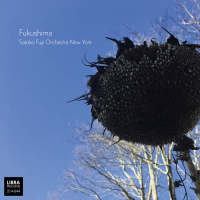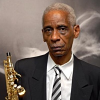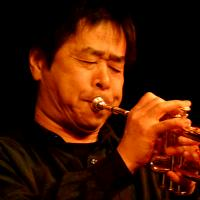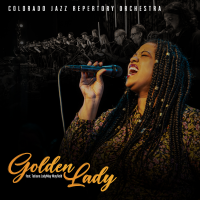Home » Jazz Musicians » Natsuki Tamura
Natsuki Tamura
Japanese trumpeter and composer NATSUKI TAMURA is internationally recognized for a unique musical vocabulary that blends extended techniques with jazz lyricism. This unpredictable virtuoso’s seemingly limitless creativity led François Couture in All Music Guide to declare that “… we can officially say there are two Natsuki Tamuras: The one playing angular jazz-rock or ferocious free improv… and the one writing simple melodies of stunning beauty… How the two of them live in the same body and breathe through the same trumpet might remain a mystery.”
Born on July 26, 1951, in Otsu, Shiga, Japan, Tamura first picked up the trumpet while performing in his junior high brass band. He began his professional music career after he graduated from high school, playing in numerous bands including the World Sharps Orchestra, Consolation, Skyliners Orchestra, New Herd Orchestra, Music Magic Orchestra, and the Satoko Fujii Ensemble, as well as in his own ensemble. He was the trumpeter for numerous national television shows in Japan from 1973–1982, including The Best Ten, Music Fair, Kirameku Rhythm and many others.
In 1986, he came to the United States to study at Berklee College of Music. He then returned to his native Japan to perform and teach at the Yamaha Popular Music School and at private trumpet studios in Tokyo and Saitama, before coming back to the US to study at New England Conservatory. He made his debut recording as a leader in 1992 on Tobifudo.
In 1997 he released the duo album How Many? with pianist Satoko Fujii, who is also his wife. It marked the beginning of an artistic collaboration that continues up to the present. The duo has made a total of five CDs over the years, including 2012’s Muku. “Muku contains some truly stunning, spine-tingling music…its sheer beauty and elegance is what lingers most,” wrote Dave Wayne in All About Jazz. “Fujii’s orchestral technique, clear chromatic lines and “prepared piano” devices contrast effectively with Tamura’s arsenal of extended techniques which he executes with a warm, vocalized tone throughout the trumpet’s full range,” Ted Panken said in his four-star DownBeat review. Tamura’s collaborations with Fujii reveal an intense musical empathy, and have garnered wide popular and critical acclaim. Jim Santella in All About Jazz described their synergy well in his glowing review of the couple’s 2006 Not Two disc, In Krakow, In November: “… the creative couple forcefully demonstrates what can happen when you let your musical ideas run free… Similarly, Tamura’s mournful trumpet can fly high or low in search of his next surprise. Oftentimes, they both issue plaintive moans that sing like angels on high.” Their sixth duet album is due out in 2017.
Tags
Satoko Fujii: Message
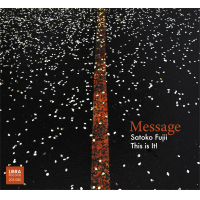
by John Sharpe
Even within the remarkably consistent output of prolific Japanese pianist Satoko Fujii, certain ensembles command special attention. The This Is It! Trio --named for her conviction that the group represented an ideal working unit has become one such forum. Message, the trio's third release, reunites Fujii with her crew -husband and trumpeter Natsuki Tamura and drummer Takashi Itani -for a program that underscores her strengths as both composer and catalytic improviser. Unlike in some of her other bands ...
Continue ReadingSatoko Fujii Quartet: Burning Wick
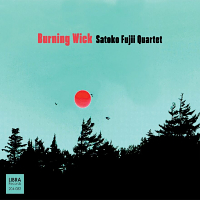
by Glenn Astarita
Few pianists alive match the relentless invention of Satoko Fujii. Born in Tokyo in 1958, she trained classically before studying jazz at Berklee and the New England Conservatory under mentors such as Paul Bley and Ran Blake. Since the 1990s she has released more than 100 albums, often marking her birthday with a new project that might drift toward meditative stillness or erupt into full-tilt big-band turbulence. The Quartet on Burning Wick--Fujii (piano), Natsuki Tamura (trumpet), Takeharu Hayakawa (bass) and ...
Continue ReadingSatoko Fujii Quartet: Burning Wick

by Dan McClenaghan
Japanese pianist Satoko Fujii is prolific. She has released well over 100 albums in a 30-year career, including a notable stretch in 2018 when she released an album a month. Solo piano outings, duo sets--including several with her husband, trumpeter Natsuki Tamura--trios, quartets, and larger ensembles of every size and shape. A general rule with Fujii: the larger the ensemble, the louder and more brazen the sounds. Her big bands are often particularly riotous. But her small ensembles ...
Continue ReadingKeiji Haino, Natsuki Tamura: What Happened There?

by Neri Pollastri
Singolare e creativo chitarrista dalla lunga carriera con esperienze nel rock e nella musica sperimentale, il giapponese Keiji Haino, classe 1952, è qui ripreso durante un concerto dal vivo presso il Shinjuku Pit Inn di Tokyo, in duo con il connazionale trombettista Natsuki Tamura, compagno artistico e di vita di Satoko Fujii: trentacinque minuti di performance improvvisata nella quale si mescolano i suoni e le suggestioni più diverse, come un vero happening. Se infatti Haino, come è solito ...
Continue ReadingNatsuki Tamura / Satoko Fujii: Ki
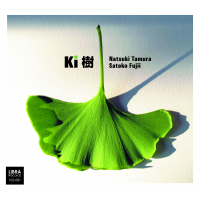
by Dan McClenaghan
The sound of Ki is deeply steeped in deliberation, dignity and old-world stateliness. This, coming from the long-term team of trumpeter Natsuki Tamura and pianist Satoko Fujii, might surprise those who have followed the duo's trajectory over its quarter-century-plus existence. Fujii and Tamura stir up musical pots and pans in a startling array of styles. Most of the dishes they cook up are avant-garde--Fujii's boisterous big band stews, Tamura's truculent treks spiced with electricity and/or extended trumpet technique tom foolery ...
Continue ReadingNatsuki Tamura / Satoko Fujii / Ramon Lopez: Yama Kawa Umi

by John Sharpe
Encounters with Japanese pianist Satoko Fujii arrive with mindboggling regularity, yet her output remains remarkably immune to routine. Yama Kawa Umi reunites her with trumpeter (and husband) Natsuki Tamura and Paris-domiciled Spanish drummer Ramon Lopez, resuming the volatile chemistry first heard on Mantle (NotTwo, 2020). Across eight compositions--five by Fujii, three by Tamura--and a brief collective, the trio sculpts improvisations within shifting frameworks, where precision can erupt from apparent disorder and dissolve just as suddenly. Despite the sparse ...
Continue ReadingKaze & Koichi Makigami: Shishiodoshi
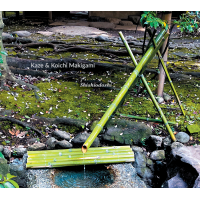
by Alberto Bazzurro
Avanguardia piuttosto spinta, attraversata da un marcato gusto per l'antigrazioso di boccioniana memoria, specie in Natsuki Tamura, da sempre braccio armato del quartetto Kaze, da lui codiretto ormai da quasi un quindicennio con la moglie Satoko Fujii, e nell'ospite del succitato quartetto, Koichi Makigami (anche allo scacciapensieri, non accreditato), soprattutto allorché impegnato alla voce (a volte nella sua declinazione di canto armonico): ecco cosa ci offre questo ennesimo album della premiata ditta di cui sopra (i coniugi, intendiamo), ormai da ...
Continue ReadingTrumpeter Natsuki Tamura Moves from One Musical Extreme to Another on Two New Releases out March 23 on Libra

Source:
Braithwaite & Katz Communications
Tamura debuts new First Meeting group and produces fourth Gato Libre album. “Tamura develops his solos with smears and slurred phrases that lead up to eruptive outbursts on his horn.... he takes his instrument to precarious heights and to burrowing depths."-- Frank Rubolino, CadenceTrumpeter Natsuki Tamura swings from the most hard-edged abstraction to the most touching lyricism on his two latest releases. On Cut the Rope (Libra) with First Meeting -- Tamura, pianist Satoko Fujii, guitarist Kelly ...
read more
Photos
Music
Burning Wick
From: Burning WickBy Natsuki Tamura
Dan's Oceanside Listening Post
From: KiBy Natsuki Tamura
Inspiration 2
From: ShishiodoshiBy Natsuki Tamura
Never Mind
From: MessageBy Natsuki Tamura
What Happened There, Part 1
From: What Happened There?By Natsuki Tamura
Not Together
From: Dog Days Of SummerBy Natsuki Tamura
Migration
From: AloftBy Natsuki Tamura
Morning City
From: NatJimBy Natsuki Tamura
One Hundred Dreams Part 1
From: Hyaku: One Hundred DreamsBy Natsuki Tamura
Summer Color
From: Summer TreeBy Natsuki Tamura
Habana's Dream
From: MosaicBy Natsuki Tamura
Sekirei
From: Koki SoloBy Natsuki Tamura
Prickly Pear Cactus
From: Prickly Pear CactusBy Natsuki Tamura
Kaineko
From: KonekoBy Natsuki Tamura
Entity
From: EntityBy Natsuki Tamura
Painted By Moonlight
From: FourBy Natsuki Tamura
1
From: FukushimaBy Natsuki Tamura














